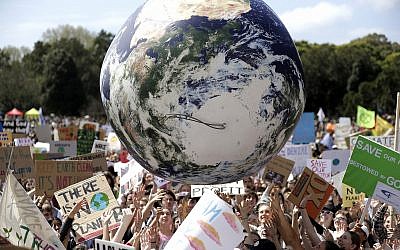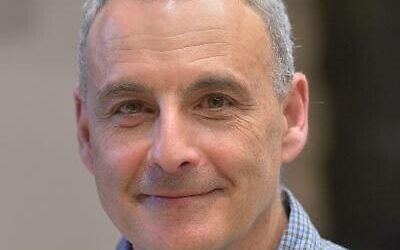As the developed world plans massive spending programs intended to help jumpstart economies across the globe once the COVID-19 pandemic recedes, much of the money is expected to go toward schemes intended to lay the foundations for a greener, healthier planet.
US President Joe Biden pledged during his election campaign to plow $2 trillion (NIS 6.5 trillion) into clean energy infrastructure over the next four years.
The European Union is set to spend 750 billion euros (NIS 2.9 trillion) — around a quarter of the union’s total budget — into a green deal to kickstart the bloc’s economy and help put the jobless back to work in sectors of the green economy.
Bodies including the OECD, International Energy Association, World Economic Forum, World Bank and International Monetary Fund recommend funneling recovery funds with an eye toward reducing carbon emissions that are causing climate change.

Then-Democratic presidential candidate and former vice president Joe Biden speaks about climate change and wildfires affecting western states in Wilmington, Delaware, September 14, 2020. (Patrick Semansky/AP)
In Israel, there are high hopes among environmentalists and civil society activists that whatever government emerges from the upcoming March Knesset election will step up to the plate on climate change as well.
For now, though, climate change appears to have fallen by the wayside. The media conversation is dominated by coverage of horse-race politics, the coronavirus and the government’s handling of the pandemic, with nary a word about global warming.
When he speaks publicly, Prime Minister Benjamin Netanyahu rarely veers from the topics of Iran and the coronavirus vaccine drive.

Israelis attend a protest calling for action against climate change outside the Knesset in Jerusalem on January 6, 2021. The gravestones read ‘In memory of the future generation.’ (Yonatan Sindel/Flash90)
But Israel does have a green recovery plan (in Hebrew), created and priced out by top economists and environmentalists, and approved by the Knesset Economics Committee.
Now all it needs is a budget — and a modest one at that.
Green shift
The plan sets out detailed budgets for implementing low-hanging fruit — that is, components of projects that are already in ministerial work plans, which can be easily put into practice.
The programs can help create jobs and boost economic growth in ways that reduce climate damage and protect the environment.
The whole plan comes with a price tag of NIS 8.3 billion ($2.5 billion), about 0.6 percent of the GDP in 2019, and about 1.7% of the government budget for that year.
The scheme was drawn up by Prof. Nathan Sussman, who directs the Center for Finance and Development at the Graduate Institute of International and Development Studies in Geneva, Switzerland, along with Ori Sharon, the deputy director of the Israel Society of Ecology and Environmental Sciences and Hila Shoef-Kollwitz, an economic and policy research consultant.
The biggest investments are reserved for the renewable energy, transportation, industry and waste sectors.

Illustrative: An aerial view of the solar field at Kibbutz Ketura, which provides one-third of the daytime electricity for the city of Eilat. (Courtesy)
It remains unclear whether the next government will deal with the state’s unprecedented estimated $50.4 billion deficit following the pandemic with austerity measures or major investments.
But according to Sussman, the infrastructure investments needed to bring down carbon emissions will help rev up the economy, creating jobs, thus putting money back into people’s pockets and increasing consumption.
He believes a green growth scheme that prioritizes such investments can run hand in hand with the government’s preferred neo-liberal, minimum-intervention approach. By correcting a market failure — pollution — rather than trying to replace the market, growth can be maintained while emissions fall.
Moreover, he says, there is a proven link between efficient, quality infrastructure and work productivity in the long run, as well as the closing of socio-economic gaps.
Among the more expensive of the plan’s proposals is a $750 million ($230 million) loan fund, which would be created to leverage NIS 3.5 billion ($1 billion) of private investment in solar energy facilities. The money would also help speed up improvements to the electricity grid to help it cope with infrastructure strains on a system that relies on solar fields and smaller solar installations around the country.
The plan would also see investment in cheaper programs, such as helping retrain workers who lost their jobs during the pandemic for skills needed in green growth industries. These could include renovating buildings to make them more energy-efficient, installing solar installations and working in recycling.
Training programs would also focus on boosting public transportation, green architecture and engineering, 3-D printing and other smart manufacturing technologies.
The plan calls for a move toward more remote working, already set in motion by the pandemic, which would open up new employment opportunities to those living far from the economic center of the country, or people with mobility issues, and save money on paying rent and utilities at an office.

A traffic jam on Highway 2 (the coastal road) near Netanya, northern Israel, October 22, 2019. (Flash90)
It would also cut road congestion and increase worker efficiency by slicing out commute times, and taking cars off the road would keep the air cleaner. Transportation is responsible for about 23% of the country’s annual carbon footprint, second only to energy, according to official data.
For those who still need to commute, the plan calls for more cycle paths, better connectivity to rail, and tax breaks on new electric cars while making up the difference with congestion pricing on roads where public transportation provision is good.
The savings are there for the taking. A Knesset research department report estimated that traffic congestion cost the economy NIS 35 million in 2019, (roughly $970 million at 2019 rates), a sum expected to go up to NIS 100 million by 2040.
The professional staffs of the relevant ministries get the need to cut carbon emissions, are committed to it and are planning for it
The recovery plan grew out of research by a committee, headed by Sussman, which looked into the macro-economic implications of moving to a low-carbon economy within the framework of “Israel 2050” — a two-year process involving government departments, academia, civil society groups and many other members of the public, under the guidance of the Israel Democracy Institute and the OECD.

Israeli activists and demonstrators hold placards as they take part in a Global Climate Strike in the Israeli coastal city of Tel Aviv on September 27, 2019 against inaction on climate change. (AHMAD GHARABLI / AFP)
The committee’s report, unveiled in mid-December at the Eli Hurvitz Conference on Economy and Society, provided an economic cost-benefit analysis, showing that a move to clean energy would cause only negligible harm to the state’s coffers while boosting economic growth, GDP and social welfare.
The report says that indirect benefits, such as improvements to health, would boost GDP even higher. OECD data shows that over 2,200 Israelis died prematurely in 2019 due to pollution-related causes, costing the economy 2.6% of its GDP.
Will the government open its wallet?
Getting the government to fund the plan is still expected to be an uphill battle. Sussman noted that during his committee’s work on Israel 2050, representatives from the Finance Ministry tended to observe and stay quiet rather than take an active role.
Recent Electricity Authority tenders have confirmed that solar energy is now cheaper than fossil fuels, even when storage costs are included. With plenty of sunshine and not much wind or water, solar power is seen as Israel’s most important renewable energy option. But the Energy Ministry is hitching the government’s wagon to the country’s offshore natural gas reserves.

Eitan Parnass, founder and CEO of the Green Energy Association of Israel. (Courtesy)
Eitan Parnass, CEO of the Green Energy Association of Israel, which lobbies for renewable energy in the country, told an IDI conference on January 20 that for renewable energy to advance, government ministries must start working together, rather than pulling in different directions, to further their individual interests.
“The Israel Lands Authority wants to make as much money as it can be allowing solar installations on its land. The [national planning council] want lots of rooftop panels, but want to charge betterment taxes …The Environmental Protection Ministry doesn’t want wind turbines [because of potential damage to migrating birds],” he said.

The unrecognized Bedouin villages around the Ramat Hovav industrial area in southern Israel suffer from a high level of air pollution from nearby chemical evaporation ponds and an Israel Electric Company power plant, December 28, 2017. (Yaniv Nadav/FLASH90)
But climate change and the need to move toward clean energy are not (yet) partisan political issues, though disagreements remain on how to get there.
The country has a slew of active, not-for-profit environmental and civil society organizations that are trying to keep up the pressure to decarbonize. Three-quarters of Israelis have already internalized that there is a link between air pollution and climate change, that the latter endangers humanity, and that the government has to prepare for it.

A large inflatable globe is bounced through the crowd as thousands of protesters, many of them school students, gather in Sydney, September 20, 2019, calling for action to guard against climate change. (AP Photo/Rick Rycroft)
The Bank of Israel as well as financial watchdogs, such as the Israel Securities Authority and Supervisor of Banks, are all talking about climate risks, and companies are starting to understand that it will be harder for them to compete in places such as the European Union, if they do not adopt green practices and take the environmental implications of their business into account.
The professional staffs of the relevant ministries already get the need to cut carbon emissions, are committed to it and are planning for it,” said Sussman.
“It’s up the Finance Ministry and the politicians to understand that something important is happening here,” he said. “The prime minister should take this on as a project — and lead.”
Related posts:
Views: 0
 RSS Feed
RSS Feed

















 January 31st, 2021
January 31st, 2021  Awake Goy
Awake Goy 




 Posted in
Posted in  Tags:
Tags: 
















